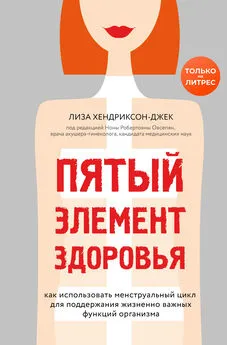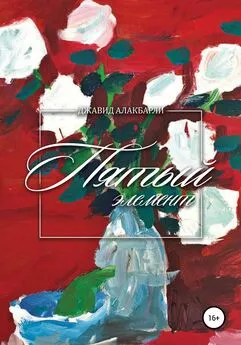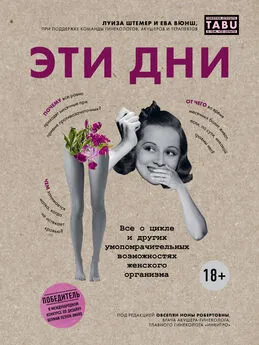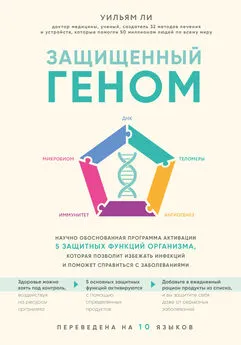Лиза Хендриксон-Джек - Пятый элемент здоровья. Как использовать менструальный цикл для поддержания жизненно важных функций организма
- Название:Пятый элемент здоровья. Как использовать менструальный цикл для поддержания жизненно важных функций организма
- Автор:
- Жанр:
- Издательство:Литагент 5 редакция
- Год:2020
- Город:Москва
- ISBN:978-5-04-104425-1
- Рейтинг:
- Избранное:Добавить в избранное
-
Отзывы:
-
Ваша оценка:
Лиза Хендриксон-Джек - Пятый элемент здоровья. Как использовать менструальный цикл для поддержания жизненно важных функций организма краткое содержание
«Почти» – потому что у женщин есть пятый показатель здоровья, на который, к сожалению, все еще мало кто обращает внимание, – это менструальный цикл. Короткий или длинный, регулярный или непредсказуемый – цикл может быть очень разным, и каждый его параметр, каждое изменение служат индикатором той или иной проблемы в организме. Планируете вы беременность или нет, овуляция имеет значение для поддержания здоровья.
Автор этой книги расскажет, что именно влияет на состояние менструального цикла, и научит вас составлять его график для максимально точного и удобного отслеживания различных изменений и контроля здоровья.
Пятый элемент здоровья. Как использовать менструальный цикл для поддержания жизненно важных функций организма - читать онлайн бесплатно ознакомительный отрывок
Интервал:
Закладка:
17. Paynter, O.E., G.J. Burin, R.B. Jaeger, and C.A. Gregorio. “Goitrogens and thyroid follicular cell neoplasia: evidence for a threshold process.” Regulatory Toxicology and Pharmacology 8, no. 1 (1988): 102–119.
18. Bianco, Antonio C., Domenico Salvatore, Balázs Gereben, Marla J. Berry, and P. Reed Larsen. “Biochemistry, cellular and molecular biology, and physiological roles of the iodothyronine selenodeiodinases.” Endocrine Reviews 23, no. 1 (2002): 59–60; Brownstein, David. (2008). Overcoming Thyroid Disorders. Arden, NC: Medical Alternatives Press.
19. Ingbar, S.H., and L.E. Braverman. “Active form of the thyroid hormone.” Annual Review of Medicine 26, no. 1 (1975): 443–449.
20. Danforth Jr., Elliot, and A.G. Burger. “The impact of nutrition on thyroid hormone physiology and action.” Annual Review of Nutrition 9, no. 1 (1989): 201–227.
21. Abdalla, Sherine M., and Antonio C. Bianco. “Defending plasma T3 is a biological priority.” Clinical Endocrinology 81, no. 5 (2014): 633–641; Pascual, Angel, and Ana Aranda. “Thyroid hormone receptors, cell growth and differentiation.” Biochimica et Biophysica Acta (BBA) – General Subjects 1830, no. 7 (2013): 3908–3916.
22. Bianco, Antonio C., Domenico Salvatore, Balázs Gereben, Marla J. Berry, and P. Reed Larsen. “Biochemistry, cellular and molecular biology, and physiological roles of the iodothyronine selenodeiodinases.” Endocrine Reviews 23, no. 1 (2002): 38–89; Abdalla, Sherine M., and Antonio C. Bianco. “Defending plasma T3 is a biological priority.” Clinical Endocrinology 81, no. 5 (2014): 633–641.
23. Garber, Jeffrey R., Rhoda H. Cobin, Hossein Gharib, James V. Hennessey, Irwin Klein, Jeffrey I. Mechanick, Rachel Pessah-Pollack, Peter A. Singer, and Kenneth A. Woeber for the American Association of Clinical Endocrinologists and American Thyroid Association Taskforce on Hypothyroidism in Adults. “Clinical practice guidelines for hypothyroidism in adults: cosponsored by the American Association of Clinical Endocrinologists and the American Thyroid Association.” Thyroid 22, no. 12 (2012): 1200–1235.
24. Hoang, Thanh D., Cara H. Olsen, Vinh Q. Mai, Patrick W. Clyde, and Mohamed K.M. Shakir. “Desiccated thyroid extract compared with levothyroxine in the treatment of hypothyroidism: a randomized, double-blind, crossover study.” The Journal of Clinical Endocrinology & Metabolism 98, no. 5 (2013): 1982–1990; Friedman, Michael, Jorge R. Miranda– Massari, and Michael J. González. “Supraphysiological cyclic dosing of sustained release T3 in order to reset low basal body temperature.” Puerto Rico Health Sciences Journal 25, no. 1 (2006): 23–29; Wilson, E. Denis. “Reversing hypometabolic symptoms by normalizing low body temperatures with sustained-release T3 in patients with euthyroid TSH levels.” Journal of Restorative Medicine 1, no. 1 (2012): 64–74.
25. McCook, Judy G., Beth A. Bailey, Stacey L. Williams, Sheeba Anand, and Nancy E. Reame. “Differential contributions of polycystic ovary syndrome (PCOS) manifestations to psychological symptoms.” The Journal of Behavioral Health Services & Research 42, no. 3 (2015): 383–394; Padmanabhan, Vasantha. “Polycystic ovary syndrome – ‘a riddle wrapped in a mystery inside an enigma.’” The Journal of Clinical Endocrinology & Metabolism 94, no. 6 (2009): 1883–1885.
26. Sirmans, Susan M., and Kristen A. Pate. “Epidemiology, diagnosis, and management of polycystic ovary syndrome.” Clinical Epidemiology 6 (2014): 1–13.
27. Chang, J., R. Azziz, R. Legro, D. Dewailly, S. Franks, R. Tarlatzis, B. Fauser et al. “Revised 2003 consensus on diagnostic criteria and long-term health risks related to polycystic ovary syndrome.” Fertility and Sterility 81, no. 1 (2004): 19–25.
28. Azziz, Ricardo, Enrico Carmina, Didier Dewailly, Evanthia Diamanti-Kandarakis, Hector F. Escobar-Morreale, Walter Futterweit, Onno E. Janssen et al. “Criteria for defining polycystic ovary syndrome as a predominantly hyperandrogenic syndrome: an androgen excess society guideline.” The Journal of Clinical Endocrinology & Metabolism 91, no. 11 (2006): 4237–4245.
29. Там же.
30. Hendrickson-Jack, Lisa. “FFP 111 | 8 Steps to Reverse Your PCOS | Inflammation, Gut Health, Thyroid Disorders & PCOS | Infertility | Autoimmunity | Dr. Fiona McCulloch, ND.” Fertility Friday Podcast. Podcast Audio, December 2, 2016. fertilityfriday.com/Fiona-McCulloch-ND
31. Wild, Robert A. “Long-term health consequences of PCOS.” Human Reproduction Update 8, no. 3 (2002): 231–241; Barry, John A., Mallika M. Azizia, and Paul J. Hardiman. “Risk of endometrial, ovarian and breast cancer in women with polycystic ovary syndrome: a systematic review and meta-analysis.” Human Reproduction Update 20, no. 5 (2014): 748–758; Harris, Holly R., and Kathryn L. Terry. “Polycystic ovary syndrome and risk of endometrial, ovarian, and breast cancer: a systematic review.” Fertility Research and Practice 1, no. 2 (2016): 1–9.
32. Maslyanskaya, Sofya, Hina J. Talib, Jennifer L. Northridge, Amanda M. Jacobs, Chanelle Coble, and Susan M. Coupey. “Polycystic ovary syndrome: an under-recognized cause of abnormal uterine bleeding in adolescents admitted to a children’s hospital.” Journal of Pediatric and Adolescent Gynecology 30, no. 3 (2017): 349–355.
33. Kirchengast, S., and J. Huber. “Body composition characteristics and body fat distribution in lean women with polycystic ovary syndrome.” Human Reproduction 16, no. 6 (2001): 1255–1260.
34. Azziz, Ricardo, Enrico Carmina, Didier Dewailly, Evanthia Diamanti-Kandarakis, Héctor F. Escobar-Morreale, Walter Futterweit, Onno E. Janssen et al. “The Androgen Excess and PCOS Society criteria for the polycystic ovary syndrome: the complete task force report.” Fertility and Sterility 91, no. 2 (2009): 456–488.
35. Azziz, Ricardo, Enrico Carmina, Didier Dewailly, Evanthia Diamanti-Kandarakis, Hector F. Escobar-Morreale, Walter Futterweit, Onno E. Janssen et al. “Criteria for defining polycystic ovary syndrome as a predominantly hyperandrogenic syndrome: an androgen excess society guideline.” The Journal of Clinical Endocrinology & Metabolism 91, no. 11 (2006): 4237–4245.
36. Balen, Adam H., Joop S.E. Laven, Seang-Lin Tan, and Didier Dewailly. “Ultrasound assessment of the polycystic ovary: international consensus definitions.” Human Reproduction Update 9, no. 6 (2003): 505–514.
37. Azziz, Ricardo, Enrico Carmina, Didier Dewailly, Evanthia Diamanti-Kandarakis, Héctor F. Escobar-Morreale, Walter Futterweit, Onno E. Janssen et al. “The Androgen Excess and PCOS Society criteria for the polycystic ovary syndrome: the complete task force report.” Fertility and Sterility 91, no. 2 (2009): 456–488.
38. Azziz, Ricardo, Enrico Carmina, Didier Dewailly, Evanthia Diamanti-Kandarakis, Hector F. Escobar-Morreale, Walter Futterweit, Onno E. Janssen et al. “Criteria for defining polycystic ovary syndrome as a predominantly hyperandrogenic syndrome: an androgen excess society guideline.” The Journal of Clinical Endocrinology & Metabolism 91, no. 11 (2006): 4237–4245.
39. Dumesic, Daniel A., Sharon E. Oberfield, Elisabet Stener-Victorin, John C. Marshall, Joop S. Laven, and Richard S. Legro. “Scientific statement on the diagnostic criteria, epidemiology, pathophysiology, and molecular genetics of polycystic ovary syndrome.” Endocrine Reviews 36, no. 5 (2015): 487–525.
40. Azziz, Ricardo, Enrico Carmina, Didier Dewailly, Evanthia Diamanti-Kandarakis, Héctor F. Escobar-Morreale, Walter Futterweit, Onno E. Janssen et al. “The Androgen Excess and PCOS Society criteria for the polycystic ovary syndrome: the complete task force report.” Fertility and Sterility 91, no. 2 (2009): 456–488.
41. Rao, Ujvala, and Roy Homburg. (2018). “Anovulation in Women with PCOS.” Infertility in Women with Polycystic Ovary Syndrome. Springer, Cham, 23–30; Cadagan, David, Raheela Khan, and Saad Amer. “Thecal cell sensitivity to luteinizing hormone and insulin in polycystic ovarian syndrome.” Reproductive Biology 16, no. 1 (2016): 53–60.
42. Azziz, Ricardo, Enrico Carmina, Didier Dewailly, Evanthia Diamanti-Kandarakis, Héctor F. Escobar-Morreale, Walter Futterweit, Onno E. Janssen et al. “The Androgen Excess and PCOS Society criteria for the polycystic ovary syndrome: the complete task force report.” Fertility and Sterility 91, no. 2 (2009): 456–488.
43. Там же.
44. Kelly, Christopher J.G., John Connell, Iain T. Cameron, Gwyn W. Gould, and Helen Lyall. “The long term health consequences of polycystic ovary syndrome.” BJOG: An International Journal of Obstetrics and Gynaecology 107, no. 11 (2000): 1327–1338.
45. Rojas, Joselyn, Mervin Chávez, Luis Olivar, Milagros Rojas, Jessenia Morillo, José Mejías, María Calvo, and Valmore Bermúdez. “Polycystic ovary syndrome, insulin resistance, and obesity: navigating the pathophysiologic labyrinth.” International Journal of Reproductive Medicine (2014): 1–17.
46. Hotamisligil, Gökhan S. “Inflammation and metabolic disorders.” Nature 444, no. 7121 (2006): 860–867.
47. Kelly, Chris C.J., Helen Lyall, John R. Petrie, Gwyn W. Gould, John M.C. Connell, and Naveed Sattar. “Low grade chronic inflammation in women with polycystic ovarian syndrome.” The Journal of Clinical Endocrinology & Metabolism 86, no. 6 (2001): 2453–2455; Ridker, Paul M., Charles H. Hennekens, Julie E. Buring, and Nader Rifai. “C-reactive protein and other markers of inflammation in the prediction of cardiovascular disease in women.” New England Journal of Medicine 342, no. 12 (2000): 836–843.
48. O’Neill, S., and L. O’Driscoll. “Metabolic syndrome: a closer look at the growing epidemic and its associated pathologies.” Obesity Reviews 16, no. 1 (2015): 1–12; Franks, Stephen. “Polycystic ovary syndrome: not just a fertility problem.” Women’s Health. (2015): 433–436.
49. Dunaif, Andrea, and Bart C.J.M. Fauser. “Renaming PCOS – a two-state solution.” The Journal of Clinical Endocrinology & Metabolism 98, no. 11 (2013): 4325–4328; Rosenwaks, Zev. “Polycystic ovary syndrome, an enigmatic syndrome begging for a name change.” Fertility and Sterility 108, no. 5 (2017): 748–749.
50. Diamanti-Kandarakis, Evanthia, Jean-Patrice Baillargeon, Maria J. Iuorno, Daniela J. Jakubowicz, and John E. Nestler. “A modern medical quandary: polycystic ovary syndrome, insulin resistance, and oral contraceptive pills.” The Journal of Clinical Endocrinology & Metabolism 88, no. 5 (2003): 1927–1932; de Melo, Anderson Sanches, Rosana Maria dos Reis, Rui Alberto Ferriani, and Carolina Sales Vieira. “Hormonal contraception in women with polycystic ovary syndrome: choices, challenges, and noncontraceptive benefits.” Open Access Journal of Contraception 8 (2017): 13–23.
51. Gordon, Catherine M. “Functional hypothalamic amenorrhea.” New England Journal of Medicine 363, no. 4 (2010): 365–371.
52. Chou, Sharon H., and Christos Mantzoros. “Bone metabolism in anorexia nervosa and hypothalamic amenorrhea.” Metabolism (2017).
53. Frisch, Rose E., and Janet W. McArthur. “Menstrual cycles: fatness as a determinant of minimum weight for height necessary for their maintenance or onset.” Science 185, no. 4155 (1974): 949–951.
54. Winkler, Laura Al-Dakhiel, Jacob Stampe Frølich, Maya Schulpen, and René Klinkby Støving. “Body composition and menstrual status in adults with a history of anorexia nervosa – at what fat percentage is the menstrual cycle restored?” International Journal of Eating Disorders 50, no. 4 (2017): 370–377.
55. Beals, Katherine A., and Amanda K. Hill. “The prevalence of disordered eating, menstrual dysfunction, and low bone mineral density among US collegiate athletes.” International Journal of Sport Nutrition and Exercise Metabolism 16, no. 1 (2006): 1–23.
Читать дальшеИнтервал:
Закладка:









